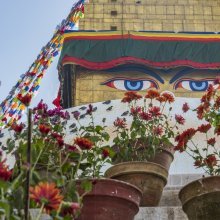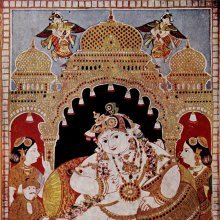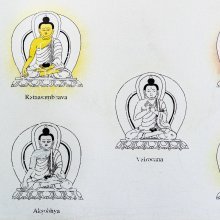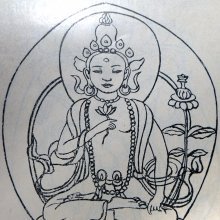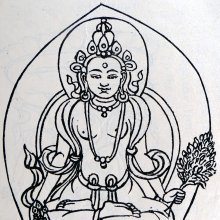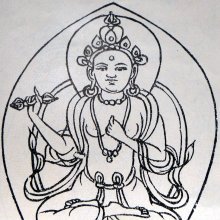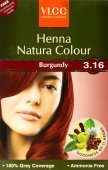Colour, Color: 3 definitions
Introduction:
Colour means something in Hinduism, Sanskrit. If you want to know the exact meaning, history, etymology or English translation of this term then check out the descriptions on this page. Add your comment or reference to a book if you want to contribute to this summary article.
Images (photo gallery)
(+225 more images available)
In Hinduism
Purana and Itihasa (epic history)
Source: Shodhganga: Elements of Art and Architecture in the Trtiyakhanda of the VisnudharmottarapuranaKnowledge of Colours refers to one of the “sixty four kinds of Art”, according to the Kamasutra of Vatsyayana.—Cf. the Sanskrit Maṇirāgākarajñāna, which refers to the “knowledge of jewel, colours and mines”.—Indian tradition, basically includes sixty four Art forms are acknowledged. The history of Indian Art covers approximately five thousand years which presents a rich and almost continuous record. The references of sixty four kinds of Kala (कला, kalā) are found in the Bhagavatapurana, Shaiva-Tantras, Kamasutra of Vatsyayana etc.

The Purana (पुराण, purāṇas) refers to Sanskrit literature preserving ancient India’s vast cultural history, including historical legends, religious ceremonies, various arts and sciences. The eighteen mahapuranas total over 400,000 shlokas (metrical couplets) and date to at least several centuries BCE.
Natyashastra (theatrics and dramaturgy)
Source: Shodhganga: Elements of Art and Architecture in the Trtiyakhanda of the Visnudharmottarapurana (natya)1) The Colour of dresses (in Indian Dramas) are conveyed through the Alaṃkāra division of Āhāryābhinaya: one of the four divisions of Abhinaya or “ways to convey or represent one’s emotion to others”, according to the Viṣṇudharmottarapurāṇa, an ancient Sanskrit text which (being encyclopedic in nature) deals with a variety of cultural topics such as arts, architecture, music, grammar and astronomy.—Alaṃkāra deals with the decoration of garlands and ornaments. [...] The colours of dresses of different characters are also discussed in the third part of the Viṣṇudharmottarapurāṇa. The colour of every costume of every character should be different. As for example, the costume of dhīrodātta type of hero is suggested as not to be very loud where as it suggests that the costume of king should be graceful. In the Nāṭyaśāstra also the dress of a king is suggested to be variegated in colour which definitely brings graceful look.
2) Colours are associated with Catura-hasta: one of the twenty-two Single-hand Gestures (in Indian Dramas) (known as asaṃyuktahastas).—According to the Viṣṇudharmottarapurāṇa, some colours are pointed with the catura hand gesture. When the hand is raised in catura posture, it denotes white colour. When the hand moves in circular way and in semi-circular motion in caturahasta, it denotes yellow and red colour respectively. In compacted form it shows blue colour. When the hand is kept in normal position with caturahasta, it denotes black and the other remaining colours.

Natyashastra (नाट्यशास्त्र, nāṭyaśāstra) refers to both the ancient Indian tradition (shastra) of performing arts, (natya—theatrics, drama, dance, music), as well as the name of a Sanskrit work dealing with these subjects. It also teaches the rules for composing Dramatic plays (nataka), construction and performance of Theater, and Poetic works (kavya).
Shilpashastra (iconography)
Source: Shodhganga: Elements of Art and Architecture in the Trtiyakhanda of the Visnudharmottarapurana (shilpa)Colours have been classified in two categories (viz., primary/natural and mixed/artificial) in the ancient Indian tradition of Painting (citra), according to the Viṣṇudharmottarapurāṇa, an ancient Sanskrit text which (being encyclopedic in nature) deals with a variety of cultural topics such as arts, architecture, music, grammar and astronomy.
In the Viṣṇudharmottarapurāṇa, five colours are regarded as the primary ones, viz.,
- white (śveta),
- yellow (pīta),
- colour of vilomata (the Emblic myrobalan),
- black (kṛṣṇa),
- dark blue (nīla).
According to the Viṣṇudharmottarapurāṇa, a painter can create hundreds or thousands of colours by amalgamating the primary colours. [...] So, it can be said that, appropriate selection, proportion and distribution of colours are very necessary to get different shades of colours.

Shilpashastra (शिल्पशास्त्र, śilpaśāstra) represents the ancient Indian science (shastra) of creative arts (shilpa) such as sculpture, iconography and painting. Closely related to Vastushastra (architecture), they often share the same literature.
See also (Relevant definitions)
Starts with: Coloured guinea grass, Colouring.
Full-text (+6072): Varna, Pita, Raga, Nila, Harita, Rakta, Shveta, Dhumra, Tamra, Vivarna, Vaivarṇya, Krishnavarna, Shyama, Kashaya, Haridra, Manjishtha, Dhusara, White, Shukla, Pandura.
Relevant text
Search found 405 books and stories containing Colour, Color; (plurals include: Colours, Colors). You can also click to the full overview containing English textual excerpts. Below are direct links for the most relevant articles:
Significance of the Moon in Ancient Civilizations (by Radhakrishnan. P)
9. Chromotherapy or Color Therapy < [Chapter 9 - Contributions of Modern Astrology]
9. Jyotishmati < [Chapter 7 - Moon the Significant Planet of Mind]
2. Illustration of Mind < [Chapter 7 - Moon the Significant Planet of Mind]
Chandogya Upanishad (Madhva commentary) (by Srisa Chandra Vasu)
Eight Adhyaya, Thirteenth Khanda (1 mantra)
Sixth Adhyaya, Fourth Khanda (7 mantras)
Brihat Samhita (by N. Chidambaram Iyer)
Chapter 34 - On Halos (pariveṣa-lakṣaṇa)
Chapter 3 - On the course of the Sun (āditya-cāra)
Philosophy of language in the Five Nikayas (by K.T.S. Sarao)
7. Correspondence of Linguistic Structures and Cognitive Structures < [Chapter 5 - Language and Thought]
9. Logical Form < [Chapter 2 - Concept of Philosophy of Language]
5. Sense versus Reference < [Chapter 5 - Language and Thought]
Maha Prajnaparamita Sastra (by Gelongma Karma Migme Chödrön)
Section A.1 - Rejecting colors < [Part 2 - Means of acquiring meditation]
Preliminary note to liberations, masteries and totalities < [Class (5) liberations, (6) masteries and (7) totalities]
Act 7.3: Description of Paranirmitavaśavartin < [Chapter XIV - Emission of rays]
Garga Samhita (English) (by Danavir Goswami)
Verse 1.2.45 < [Chapter 2 - Description of the Abode of Śrī Goloka]
Verse 5.13.19 < [Chapter 13 - The Arrival of Sri Uddhava]
Verses 5.3.11-12 < [Chapter 3 - Akrūra’s Arrival]
Related products
(+143 more products available)
